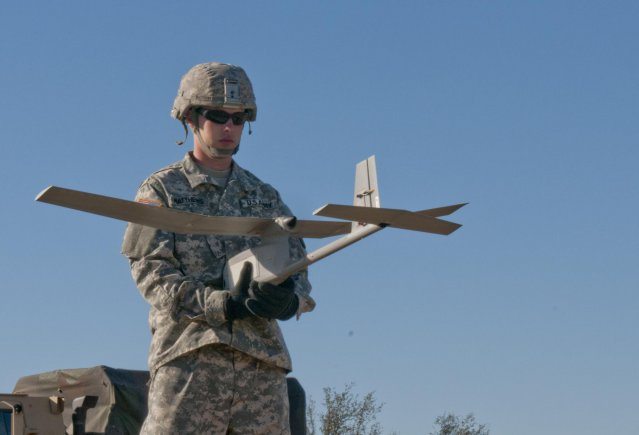Silently circling high above the ground, the unmanned aerial vehicle RQ-11 Raven’s camera focused in on its target. The operator, Sgt. Jason Lundquist, controlled the Raven’s actions from a ground station. He zoomed in on his target, taking multiple pictures as his aircraft made another pass. He was on a reconnaissance mission and these photos may save someone’s life in the future.
“Go ahead and bring it in for landing,” said Staff Sgt. Luther Oldfield, a master Raven trainer with Headquarter and Headquarters Battery, 1st Battalion 82nd Field Artillery, 1st Brigade Combat Team.
Lundquist, a team leader for 64th Military Police Company, 720th MP Battalion, entered the landing commands into his controller; the Raven reoriented itself and began its descent. It slowly glided in and hit the ground, breaking apart into nine pieces on impact, a unique characteristic of its landing procedure. This was day one of the hands-on portion of the Raven certification course.
The course is a total of two weeks, said Pfc. Cole Clark, an MP with 64th MP Company. The students started at a beginner’s level. The first week covered basic avionics of the Raven system, and emergency procedures.
“What I am teaching is ground avionics, which is flying an aircraft from a ground station,” said Oldfield. “The antennas of the system have a range of up to 10 kilometers.”
Flying the Raven is not difficult, however, there is still basic aviation information an operator must know to fly, such as bearing, heading, and wind speed.
For landing, the Raven has to face into the wind and it is programmed to guide itself in a coast all the way toward the ground. Landing is unique because there are built-in break points that are designed to break apart on impact, which to the unfamiliar eye looks a lot like a catastrophic crash. However, the Raven is very tough and undamaged.
The Ravens can be mount-operated. Units can have the control station mounted in a vehicle, launch the Raven and have it flying over the top of the unit while they do their patrol.
“Its primary function is reconnaissance, but you can use it for target acquisition or battle site damage assessment,” said Oldfield, a native of Albuquerque, N.M. “The MPs can fly the Raven over the roads of a city to see if there are any ambushes and check rooftops for snipers. With the Raven, operators can sight their targets, call for fire and verify the target was destroyed.”
“Anytime you can send a piece of equipment into an area so a Soldier doesn’t have to put his life on the line [that] is always a plus,” said Oldfield. “The Ravens are quiet, so the enemy won’t know it’s there, especially at night.”
It is a fascinating piece of equipment and there are going to be some good job opportunities in the future here in the U.S. and across the world, said Clark, a Whitewright, Texas, native. This training is a great opportunity for everyone.
“In the year 2015, [the Federal Aviation Administration] is going to open up the national air space for unmanned aerial vehicles,” said Oldfield. “So not only am I training these guys to fly for the Army, but they can actually take the certification to the civilian sector as well. This is going to be a good field, in 2015.”
Police departments and border patrol are going to want to use UAVs, said Lundquist, a Lakeville, Minn., native. It’s going to be a whole new industry and a lot of the experienced pilots are going to initially come from the military.
“I volunteered to do this,” said Lundquist. “I thought it would be a great new experience. I always like trying new things that the Army has to offer. It is just great to be part of a team that helps those downrange stay safe.”
As another team launched a Raven into the air, one thing was certain: The MPs will continue to secure the safety of their fellow Soldiers who are deployed.










